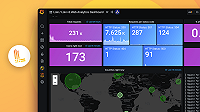Important: This documentation is about an older version. It's relevant only to the release noted, many of the features and functions have been updated or replaced. Please view the current version.
Migrate To Three Scalable Targets
This guide will walk you through migrating from the old, two target, scalable configuration to the new, three target, scalable configuration. This new configuration introduces a backend component, and reduces the read component to running just a Querier and QueryFrontend, allowing it to be run as a kubernetes Deployment rather than a StatefulSet.
Before you begin:
We recommend having a Grafana instance available to monitor both the existing and new clusters, to make sure there is no data loss during the migration process. The loki chart ships with self-monitoring features, including dashboards. These are useful for monitoring the health of the cluster during migration.
To Migrate from a “read & write” to a “backend, read & write” deployment
- Make sure your deployment is using a new enough version of loki
This feature landed as an option in the helm chart while still in the main branch of Loki. As a result, depending on when you run this migration, you may neeed to manually override the Loki or GEL image being used to one that has the third, backend target available. For loki, add the following to your values.yaml.
loki:
image:
repository: "grafana/loki"
tag: "main-f5fbfab-amd64"For GEL, you’ll need to add:
enterprise:
image:
repository: "grafana/enterprise-logs"
tag: "main-96f32b9f"- Set the
legacyReadTargetflag to false
Set the value read.legacyReadTarget to false. In your values.yaml, add:
read:
legacyReadTarget: false- Upgrade the helm installation
Run helm upgrade on your installation with your updated values.yaml file.



